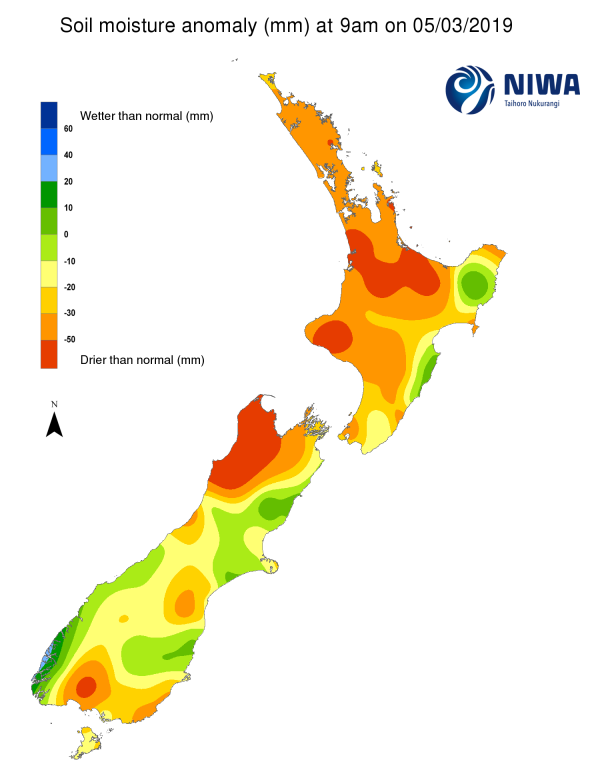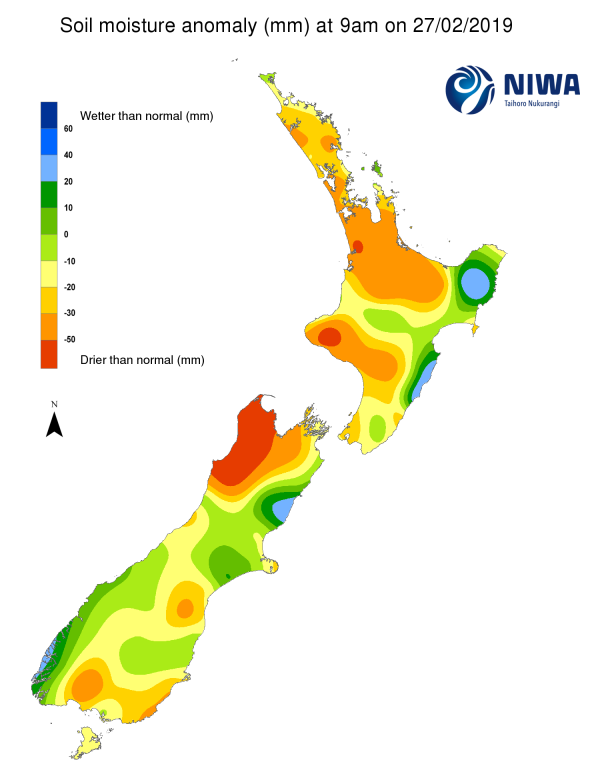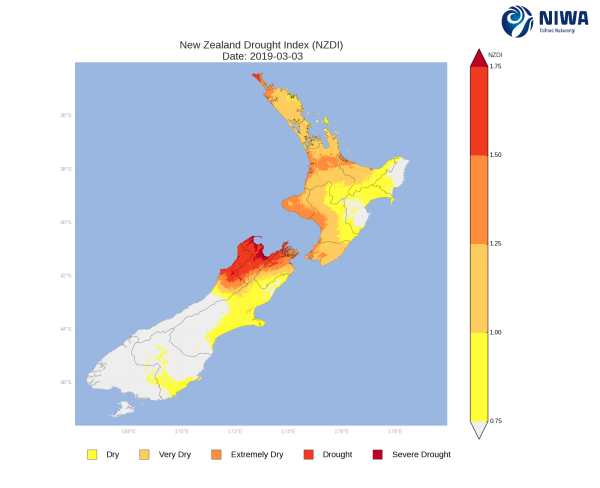A weekly update describing soil moisture across the country to help assess whether severely to extremely dry conditions are occurring or imminent. Regions experiencing these soil moisture deficits are deemed “hotspots”. Persistent hotspot regions have the potential to develop into drought.
Facts: Soil Moisture
Across the North Island, soil moisture levels decreased everywhere during the past week due to widespread meagre rainfall. The most significant decreases were observed in western Bay of Plenty, and Waikato (including the Coromandel). Other notable decreases occurred in the Auckland region, and in Northland and Manawatu-Wanganui. The driest soils across the North Island compared to normal for this time of the year are found in parts of Waikato, Bay of Plenty and Taranaki, along with a small portion of eastern Northland. The wettest soils for this time of the year are located in parts of Gisborne, eastern Bay of Plenty and southern coastal Hawke’s Bay.
Areas deemed hotspots have expanded over the past week. Hotspots now encompass large parts of Northland, Auckland, northern and central Waikato, central and western Bay of Plenty, south Taranaki, Manawatu-Wanganui, along with Wellington.
Across the South Island, soil moisture levels decreased nearly everywhere due to rainfall well below normal for this time of year. The driest soils across the South Island compared to normal continue to be found in the Tasman Region and Buller District along with an area west of Invercargill. The wettest soils for this time of the year are found in Fiordland.
Areas deemed hotspots have expanded in the past week. Hotspots now encompass large portions of the Tasman Region, Buller District, Nelson and Marlborough. In addition, Hotspots are also found in eastern Banks Peninsula, south-central Canterbury, coastal southern Otago and a portion of Southland.
Outlook and Soil Moisture
For the North Island, a front is expected to bring moderate to heavy rainfall on Friday (8 March) with showers lingering on Saturday and Sunday (9-10 March). Rainfall totals associated with the event may reach 30-40 mm in parts of central and lower North Island, with the potential for higher rainfall totals in the Gisborne Ranges and the Central Plateau. The upper North Island along with the lower east coast may see rainfall totals exceeding 15 mm, while rainfall totals in the Far North and coastal Hawke’s Bay are expected to be less than 10 mm. A period of more tranquil weather is expected from Monday (11 March) with only isolated showers possible.
Due to the rainfall anticipated with the incoming front, soil moisture levels are expected to increase in the majority of the North Island, with the greatest improvements expected in Gisborne, Bay of Plenty, the Central Plateau along with the lower west coast. Soil moisture levels may remain near constant in Northland and along the lower east coast. The majority of the current hotspots will likely weaken or decrease in size over the next week.
For the South Island, the same front is expected to bring moderate to heavy rain on Thursday (7 March), with showers lingering in the north on Friday (8 March). Rainfall totals may exceed 40 mm along the west coast, 15-20 mm in the interior, and less than 10 mm along coastal Canterbury and Otago. An overall tranquil weekend is expected with only isolated showers possible. A front may bring showers, mainly to western areas, on Monday and Tuesday (11-12 March) with more steady rain possible on Wednesday (13 March).
Weekly rainfall of 40-50 mm is possible for the western and far north South Island, with isolated higher rainfall totals possible in the central and lower West Coast Region along with coastal Fiordland. Rainfall totals east of the Alps is expected to be 20-25 mm with total rainfall less than 15 mm along coastal Canterbury and Otago. Due to the anticipated weekly rainfall, the majority of the hotspots will weaken and decrease in the upcoming week. However, the hotspots in eastern Banks Peninsula and coastal southern Otago may remain constant.
Background
Hotspot Watch: a weekly advisory service for New Zealand media. It provides soil moisture and precipitation measurements around the country to help assess whether extremely dry conditions are imminent.
Soil moisture deficit: the amount of water needed to bring the soil moisture content back to field capacity, which is the maximum amount of water the soil can hold.
Soil moisture anomaly: the difference between the historical normal soil moisture deficit (or surplus) for a given time of year and actual soil moisture deficits.
Definitions: “Extremely” and “severely” dry soils are based on a combination of the current soil moisture status and the difference from normal soil moisture. See soil moisture maps.
Hotspot: A hotspot is declared if soils are "severely drier than normal" which occurs when Soil Moisture Deficit (SMD) is less than -110 mm AND the Soil Moisture Anomaly is less than -20 mm.
-
Related information



